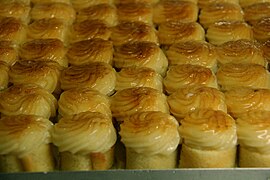Pionono
 | |
| Type | Pastry |
|---|---|
| Place of origin | Spain |
Pionono describes different sweet or savory pastries from Granada, Spain, the Caribbean, South America, and the Philippines. It is named after Pope Pius IX's name in Spanish, "Pío Nono".[1][2]
By country[]
Spain[]
Piononos are small pastries traditional in Santa Fe, a small town adjacent to the city of Granada, Spain. A pionono has two parts: a thin layer of pastry rolled into a cylinder, drenched with different kinds of syrup which give the pionono a sweet and pleasant texture, and crowned with toasted cream. It is typically eaten in one or two bites.
South America and Cuba[]
In various South American countries such as Argentina, Uruguay, Paraguay, Venezuela, Colombia, Peru and Cuba, piononos are prepared using a dough made of flour, eggs, and sugar, which is baked in a thin sheet then rolled around a filling of dulce de leche sometimes with walnuts, or fruits like strawberries with chantilly cream, or in the case of savory piononos with cured ham, cheese, tomato and mayonnaise, or a savory salad, such as ham salad with asparagus and lettuce, chicken salad or even tuna. In Cuba and in several other countries it is also called "Brazo de Gitano" or "Brazo Gitano".
Puerto Rico[]
In Puerto Rico, piononos are prepared using yellow, or sweet, plantains as the "bread" around a savory filling. It is usually stuffed with a meat filling usually picadillo, seafood or vegetables with cheese; the whole sandwich is dipped in a batter made from flour and eggs and then deep-fried.
Philippines[]
In the Philippines, pionono is more commonly spelled as pianono. It is a rolled sponge cake and is more accurately a type of jelly roll. It consists of a layer of pastry made from eggs, sugar, and sifted flour baked in a sheet. Once cooled, jelly or other types of filling is spread over the pastry. It is then rolled from one end to the other. Its most common traditional filling is simply sugar and butter (or margarine), similar to the other forms of the Filipino mamón (sponge cakes). Modern versions, however, are commonly frosted and can include a variety of fillings.[3][4]
Gallery[]

Piononos from Málaga

Piononos from Santa Fe, Spain
Homemade Argentine piononos
Sliced Savory Argentine pionono, with Ham, cheese, Salsa golf and vegetables

Sweet Argentine piononos

Sliced sweet Argentine pionono

Sweet Argentine piononos with dulce de leche

Philippine brazo de Mercedes
Ube macapuno pianono from the Philippines
See also[]
- Brazo de Mercedes
- Swiss roll
- Yule log (cake)
- Nut roll
References[]
- ^ Fenix, Mickey (28 August 2014). "'Bibingka,' 'monay,' 'escandaloza' and other curious names of Philippine baked goodies". Inquirer.net. Retrieved 4 December 2014.
- ^ Ocampo, Ambeth R. (9 January 2015). "From Pius IX to 'Pio Nono'". Philippine Daily Inquirer. Retrieved 22 April 2019.
- ^ "Pianono". Ang Sarap. Retrieved 22 April 2019.
- ^ "Pianono (Filipino Sponge Cake Roll)". Kawaling Pinoy. Retrieved 22 April 2019.
External links[]
- Caribbean cuisine
- Colombian cuisine
- Argentine pastries
- Spanish pastries
- Peruvian desserts
- Puerto Rican cuisine
- Venezuelan cuisine
- Philippine pastries
- Pope Pius IX









